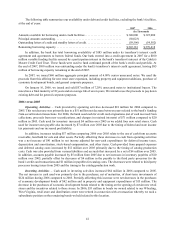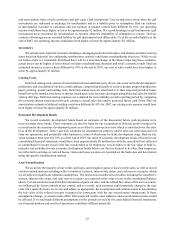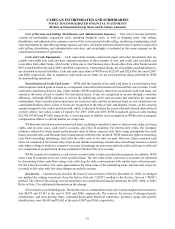Cabela's 2007 Annual Report Download - page 54
Download and view the complete annual report
Please find page 54 of the 2007 Cabela's annual report below. You can navigate through the pages in the report by either clicking on the pages listed below, or by using the keyword search tool below to find specific information within the annual report.48
Certain of these assumptions and estimates will change in the future with changes in market and economic
conditions. For example, rates paid to investors, as well as projected interest income, are primarily variable rates
which change with market interest rate changes, and loan payment rates could fluctuate based on general economic
conditions. Changes in these factors may result in future estimates of the excess spread and payment rates being
materially different from the estimates used in 2007. Refer to Note 4 for the sensitivity analysis of the current fair
value of retained interests and the impact on fair value from an immediate adverse change of 10% and 20% in the key
economic assumptions used to determine fair value.
Recent Accounting Standards and Pronouncements
In September 2006, the FASB issued FAS No. 157, Fair Value Measurements (“FAS 157”). This statement
defines fair value, establishes a framework for measuring fair value, and requires expanded disclosures about fair
value measurements. FAS 157 is effective for financial statements issued in fiscal years beginning after November
15, 2007, or beginning in 2008 for us. We have evaluated the impact of this statement to us, and we do not believe
that the adoption of the provisions of this statement will have a material impact on our financial position or results
of operations.
In February 2007, the FASB issued FAS No. 159, The Fair Value Option for Financial Assets and Financial
Liabilities – Including an Amendment of FASB Statement No. 115 (“FAS 159”). This statement permits entities to
choose to measure many financial instruments and certain other items at fair value. FAS 159 is effective as of the
beginning of an entity’s first fiscal year that begins after November 15, 2007. We evaluated the provisions of this
statement and did not elect to adopt the fair value option on any financial instruments or other items held by us on
December 29, 2007.
In December 2007, the FASB issued FAS No. 141R, Business Combinations (“FAS 141R), which replaces
FAS No. 141. FAS 141R establishes principles and requirements for how the acquirer of a business recognizes and
measures in its financial statements the identifiable assets acquired and the liabilities assumed. This statement
applies prospectively to all business combinations for which the acquisition date is on or after the beginning of the
first annual reporting period beginning on or after December 15, 2008. FAS 141R will be applicable to us beginning
in 2009.
In December 2007, the FASB issued FAS No. 160, Noncontrolling Interests in Consolidated Financial
Statements – an amendment of ARB No. 51 (“FAS 160”). This statement amends ARB No. 51 to establish accounting
and reporting standards for the noncontrolling interest in a subsidiary and for the deconsolidation of a subsidiary.
FAS 160 is effective for fiscal years beginning on or after December 15, 2008, including interim periods. We do
not believe that the adoption of this statement will have a material effect on our financial position or results of
operations.
ITEM 7A. QUANTITATIVE AND QUALITATIVE DISCLOSURES ABOUT MARKET RISK
We are exposed to interest rate risk through our bank’s operations and, to a lesser extent, through our
merchandising operations. We also are exposed to foreign currency risk through our merchandising operations.
Financial Services Interest Rate Risk
Interest rate risk refers to changes in earnings or the net present value of assets and off-balance sheet positions,
less liabilities (termed “economic value of equity”) due to interest rate changes. To the extent that interest income
collected on managed credit card loans and interest expense do not respond equally to changes in interest rates, or
that rates do not change uniformly, securitization earnings and economic value of equity could be affected. Our net
interest income on managed credit card loans is affected primarily by changes in short term interest rate indices
such as London Inter-Bank Offered Rate (“LIBOR”) and the prime rate. The variable rate credit card loans are
indexed to the prime rate. Securitization certificates and notes are indexed to LIBOR-based rates of interest and are
periodically repriced. Certificate of deposits are priced at the current prevailing market rate at the time of issuance.
We manage and mitigate our interest rate sensitivity through several techniques, but primarily by modifying the
contract terms with our cardholders, including interest rates charged, in response to changing market conditions.
Additional techniques we use include managing the maturity, repricing, and distribution of assets and liabilities by
issuing fixed rate securitization certificates and notes, and by entering into interest rate swaps to hedge our fixed rate
exposure from interest strips. The table below shows the mix of our credit card account balances at the years ended:
























